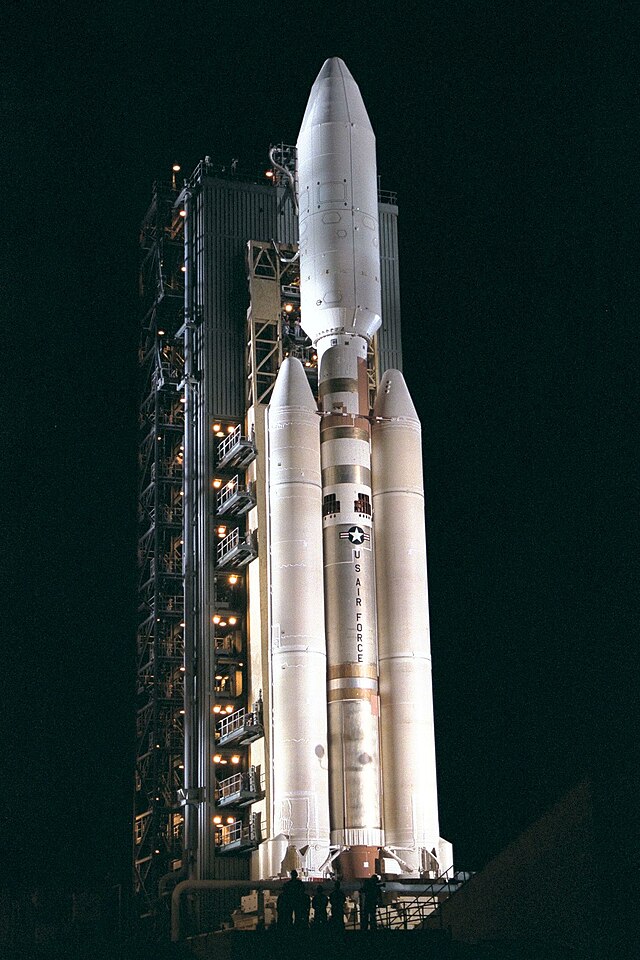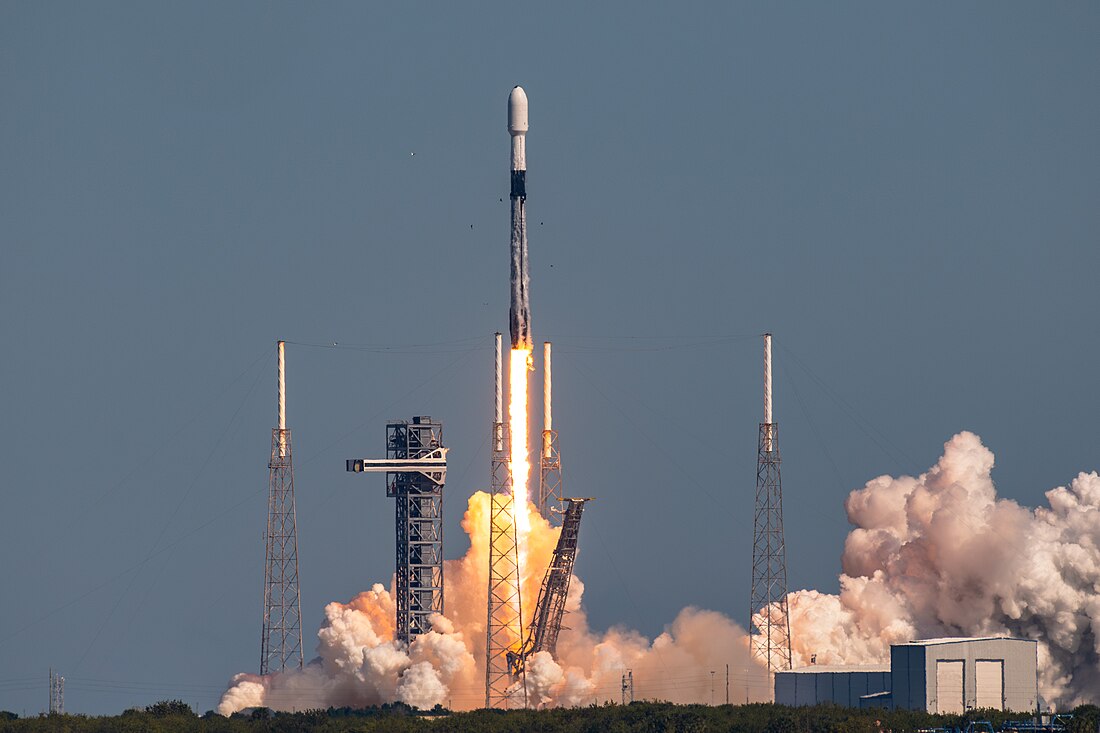Top Qs
Timeline
Chat
Perspective
Cape Canaveral Space Launch Complex 40
Rocket launch site in Florida, US From Wikipedia, the free encyclopedia
Remove ads
Space Launch Complex 40 (SLC-40), sometimes referred to as "Slick Forty," is one of two launch pads located at the Integrate-Transfer-Launch Complex in Cape Canaveral Space Force Station, Florida.[2] It initially opened as Launch Complex 40 (LC-40) and was used by the United States Air Force alongside the neighboring Space Launch Complex 41 for the Titan III program. It first saw use by the Titan IIIC throughout the 1960s and 1970s, before getting retrofitted for the Titan 34D during the 1980s. In the 1990s, Martin Marietta and the Air Force upgraded it to launch the Commercial Titan III, but the rocket's lack of success caused the pad to be used by the Titan IV throughout the decade and into the 2000s.
Following the Titan family's retirement, the SLC-40 lease was given to SpaceX in 2007 for use by their new rocket, the Falcon 9. Since the early 2010s, the pad has transformed into a high-volume launch site for the Falcon 9, being mainly used to service the company's Starlink megaconstellation. As of November 2025, the pad has hosted over 290 Falcon 9 launches.
In near future, SpaceX will add a new Falcon 9 landing zone within the SLC‑40 launch complex to replace Landing Zones 1 and 2.[3][4]
Remove ads
History
Summarize
Perspective
Titan IIIC and 34D (1965–1989)

Launch Complex 40 was originally constructed by the United States Air Force as one of two launch pads of the Integrate-Transfer-Launch Complex (ITL), tasked with launching Titan III rockets with solid rocket boosters.[5] The ITL was similar to Launch Complex 39 at the nearby Kennedy Space Center, where Titans would get assembled at the Vertical Integration Building (demolished in 2006), have their boosters built and attached at the Solid Motor Assembly Building (now used by SpaceX to process Falcon 9 payloads), and launched from either LC-40 or Launch Complex 41 (LC-41, now SLC-41).
LC-40 hosted its inaugural launch in June 1965, a Titan IIIC rocket with a 9,500 kg (21,000 lb) mass simulator to test the Transtage upper stage. Almost every Titan IIIC launch from the pad carried a military payload, the vast majority of them being classified reconnaissance satellites. Additionally, the ITL was planned to launch the Titan IIIM for the Air Force's Manned Orbiting Laboratory (MOL) program, using it as a testing ground before the operational launch site at Vandenberg Air Force Base's SLC-6 would be activated. The only MOL launch made before the program's cancellation occurred at LC-40, with OPS 0855 lifting off in November 1966 with the first capsule to be reused, Gemini SC-2 previously flown on Gemini 2.
Going into the 1970s, LC-40 became the dedicated launch site for the Titan IIIC within the ITL, as LC-41 would undergo modifications to launch the Titan IIIE. Throughout the rest of the decade, the complex would see approximately one to three Titan IIIC launches a year until the rocket's replacement with the Titan 34D in the early 1980s. Similarly to its predecessor, every Titan 34D launch from the pad was for military purposes, being used to put payloads into geostationary transfer orbit.
Commercial Titan III and Titan IV (1990–2005)
In the late 1980s, Titan manufacturer Martin Marietta and the Air Force converted the ITL to their new Titan configurations: LC-40 would be used to launch the civilian-focused Commercial Titan III, while LC-41 would be for the military-oriented Titan IV. Additionally, Titan IV processing would go through the newly built Solid Motor Assembly and Readiness Facility (now used by United Launch Alliance for future assembly of Vulcan Centaur rockets) before launch. This setup did not last, as the Commercial Titan III's price compared to cheaper systems like Delta II and Ariane 4 limited its customer base into early retirement. That being said, a handful of notable payloads were launched from LC-40 in this era, like Intelsat 603 in March 1990 (of which a stage malfunction caused it to be visited by Space Shuttle Endeavour during STS-49) and the failed Mars Observer in September 1992.

Following the Commercial Titan III's retirement, LC-40 was converted to complement LC-41 in the launches of the Titan IV. As was typical for the Titan family, almost all launches in the decade carried military payloads; the only exception to this was NASA and ESA's Cassini–Huygens mission to Saturn in October 1997. Going into the new millennium, the cost of Titan launches led to Lockheed Martin (who assumed the control of Titan following Martin Marietta's merger with Lockheed) winding down and announcing the retirement of the Titan family in favor of their cheaper Atlas launch vehicles. As such, the last Titan IV launches at the ITL were made from LC-40, with LC-41 and the SMARF converted to process and launch the Atlas V. Over its lifetime, LC-40 supported a total of 55 Titan launches, including 26 Titan IIICs, eight Titan 34Ds, four Commercial Titan IIIs, and 17 Titan IVs. The final Titan launch from LC-40 was the Lacrosse-5 reconnaissance satellite carried on a Titan IV-B on April 30, 2005.[6]
Following the conclusion of Titan operations, the launch complex underwent significant transformation. The tower was dismantled in early 2008, followed by the controlled demolition of the Mobile Service Structure later that year.[5]
SpaceX and Falcon 9 (2007–present)

SpaceX leased LC-40 from the U.S. Air Force in April 2007 to launch its Falcon 9 rocket, getting renamed to SLC-40 much like what happened to SLC-41 and SLC-37.[7] Ground facility construction began the following year, including a rocket and payload preparation hangar and new fuel tanks. A spherical liquid oxygen tank previously used at LC-34 was purchased from NASA.
The first Falcon 9 arrived in late 2008, with the inaugural launch in June 2010 carrying a dummy payload. A Dragon spacecraft demonstration flight followed in December. Starting in 2012, SLC-40 became the primary launch site for the Dragon cargo vehicle providing provide two-way logistics to and from the International Space Station, a role previously filled by the Space Shuttle until its retirement in 2011.[8]
To accommodate the heavier Falcon 9 v1.1 rocket, the launch pad was modified in 2013.[9] Launch frequency gradually increased from 2014, with a mix of Dragon and satellite missions.
A catastrophic explosion occurred at SLC-40 in September 2016 during a static fire test, destroying a Falcon 9 rocket and its payload, the AMOS-6 satellite. The incident caused significant damage to the launch pad.[10][11] After a thorough investigation and cleanup, repairs and upgrades began in early 2017.[12] SLC-40 returned to service in December 2017 with the successful launch of CRS-13.[13][14][15]
SpaceX had leased Launch Complex 39A (LC-39A) at the nearby Kennedy Space Center from NASA in April 2014, which allowed launches to continue to from Florida during the reconstruction of SLC-40. In August 2018, LC-39A's crew access tower received an access arm, allowing crew to be loaded onto Crew Dragon 2 capsules along with late payload changes on Cargo Dragon 2 capsules. Because SLC-40 lacked an access tower, Dragon missions were paused after the original Dragon 1 capsule was retired in 2020.[16]

In the 2020s, SLC-40 would become SpaceX's "workhorse" launch pad, hosting less complex satellite launch missions as frequently as every week, completing 50 launches of this launch pad alone in 2023. Meanwhile, LC-39A was used less, being reserved for Dragon crew and cargo flights, Falcon Heavy missions, and other complex missions.[16]
To add additional operational flexibility and reduce reliance on LC-39A, in early 2023, SpaceX began constructing an access tower at SLC-40.[16] In February 2024, SpaceX tested its new emergency escape system for future crewed missions, which uses an evacuation slide instead of the slidewire baskets used at LC-39A.[17]
The tower was first used ahead of in early 2024 to accommodate late loading of supplies into cargo spacecraft.[16][18] SLC-40 was used to launch its first crewed mission in September 2024, SpaceX Crew-9.[19] The mission had been slated to use LC-39A, but was shifted to SLC-40 when the launch was delayed due to issues with the Boeing Starliner Calypso spacecraft that was docked to the ISS. In addition, the delay would have bled into LC-39A's conversion process into Falcon Heavy launches, as one was being used to launch NASA's Europa Clipper in October.[20]
In near future, SpaceX will make a new Falcon 9 landing pad within SLC‑40 launch complexes to eliminate use of Landing Zones 1 and 2.[21][22]
Remove ads
Launch history
Summarize
Perspective
Active pads
Active pads not used for launches
Inactive leased pads
Inactive unleased pads
Statistics
10
20
30
40
50
60
70
80
1965
1970
1975
1980
1985
1990
1995
2000
2005
2010
2015
2020
2025
Titan III and IV
All IIIC, 34D, and IV flights operated by the United States Air Force. All Commercial flights operated by Martin Marietta.
Falcon 9 (2010–23)
All flights operated by SpaceX.
Falcon 9 (2024)
All flights operated by SpaceX.
Falcon 9 (2025)
All flights operated by SpaceX.
Upcoming launches
Remove ads
References
Wikiwand - on
Seamless Wikipedia browsing. On steroids.
Remove ads



